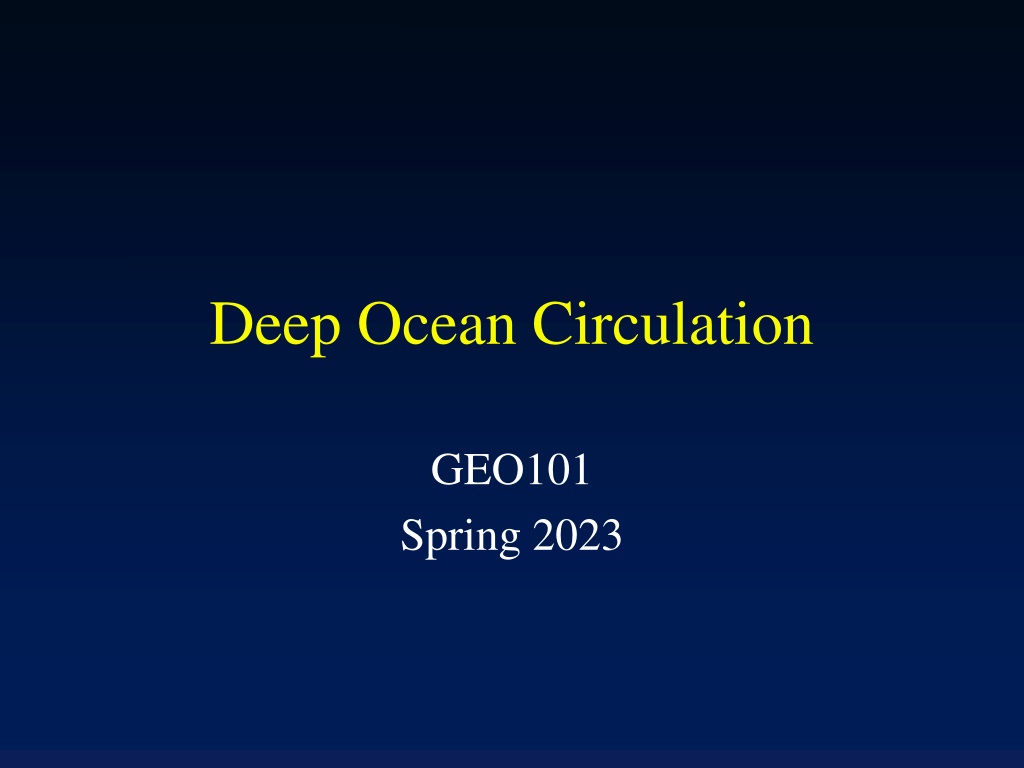Understanding Deep Ocean Circulation and Salinity Patterns
Explore the intricate relationship between ocean salinity, vertical structure, and deep-water currents in this informative collection of images and explanations. Discover how salt inputs and outputs influence ocean salinity levels, and learn about the factors that contribute to the vertical variations in temperature, salinity, and density within the oceans. Gain insights into the mechanisms driving the complex patterns of deep ocean circulation and their impact on climate.
Download Presentation

Please find below an Image/Link to download the presentation.
The content on the website is provided AS IS for your information and personal use only. It may not be sold, licensed, or shared on other websites without obtaining consent from the author. Download presentation by click this link. If you encounter any issues during the download, it is possible that the publisher has removed the file from their server.
E N D
Presentation Transcript
Deep Ocean Circulation GEO101 Spring 2023
Contents Ocean Salinity The Vertical Structure of Oceans Deep-water Formation The Thermohaline Conveyor Belt Deep Ocean Currents and Climate
Ocean salinity salinity = salt Ocean is 3.5% salt. extra density concentrated in oceans: Precipitation dissolves salts. Rivers transport. Evaporation leaves the salt. [31.5%]
Ocean salinity oceans ever-saltier? early oceans less salty, but stable for last 1.5 billion years input = outputs
Salt deposits Biological uptake (e.g., coral) Salt spray
Ocean salinity spatial variation salt inputs: rivers (e.g., Mediterranean & Nile) salt outputs: sediments or spray water loss minus gain: sea ice: ice crystals exclude salt evaporation precipitation
Ocean Salinity evaporation - precipitation
Ocean Salinity Brinicle video
The Vertical Structure of Oceans Ocean water varies vertically in terms of: temperature: As you go deeper, temperature drops. Sun and atmosphere warmth salinity: As you go deeper, salinity increases. salt inputs from river and rainfall deep ocean receives salt no freshwater
Vertical Structure of Oceans water density: As you go deeper, density increases. Why? higher salinity pressure from overlying water lower temperature (note: freshwater density peaks at 4 C)
Vertical Structure of Oceans three general layers: surface layer: warm, mixed by wind transition zone: rapid changes deep water: cold, salty, dense. How do the three layers mix?
Deep-water Formation surface water moved by wind Density and salinity change with latitudes. Evaporation increases salinity. Ice formation increases salinity. Cooling increases density. Cold, dense water sinks. Deep-water formed as: North Atlantic Deep Water (NADW), off the coast of Greenland Antarctic Bottom Water (AABW), off Antarctica
The Thermohaline Conveyor Belt Sinking water creates a conveyor belt . thermohaline (temperature and salinity) After sinking, NADW travels south and joins AABW. Water upward in Indian Ocean and North Pacific Ocean deep water: 17 ft hr-1, residence time = 500 years conveyor belt moves: nutrients water
the thermohaline conveyor belt circulation connecting the surface currents (dotted lines) with deep-ocean currents (solid line).
Deep Ocean Currents and Climate Deep ocean delivers cold water, thus cools atmosphere. Thermohaline circulation plays an important role in the carbon cycle by moving CO2-rich surface waters into the ocean depths. It could be slowed or stopped by inputs of fresh water into the North Atlantic.
Deep Ocean Currents and Climate Fresh water inputs could come from the sudden drainage of large lakes formed by melting ice at the close of the last Ice Age. The fresh water would decrease the density of the ocean water, keeping the water from sinking. Without sinking, circulation would stop. This would interrupt the transfer of heat from equatorial regions to the northern midlatitudes. This mechanism could result in relatively rapid climatic change and is one explanation for periodic cycles of warm and cold temperatures since the melting of continental ice sheets about 12,000 years ago.

























